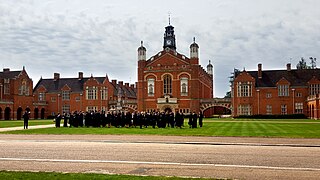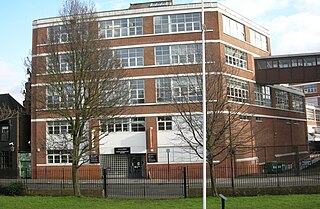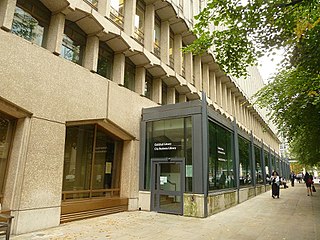
William Wordsworth was an English Romantic poet who, with Samuel Taylor Coleridge, helped to launch the Romantic Age in English literature with their joint publication Lyrical Ballads (1798).

Edmund Charles Blunden was an English poet, author, and critic. Like his friend Siegfried Sassoon, he wrote of his experiences in World War I in both verse and prose. For most of his career, Blunden was also a reviewer for English publications and an academic in Tokyo and later Hong Kong. He ended his career as Professor of Poetry at the University of Oxford. He was nominated for the Nobel Prize in Literature six times.

James Henry Leigh Hunt, best known as Leigh Hunt, was an English critic, essayist and poet.

Charles Lamb was an English essayist, poet, and antiquarian, best known for his Essays of Elia and for the children's book Tales from Shakespeare, co-authored with his sister, Mary Lamb (1764–1847).

Christ's Hospital is a public school with a royal charter, located to the south of Horsham in West Sussex. The school was founded in 1552 and the royal charter granted in 1553. Since its establishment, Christ's Hospital has been a charity school, with a core aim to offer children from disadvantaged backgrounds the chance of a better education.

The Worshipful Company of Clockmakers was established under a Royal Charter granted by King Charles I in 1631. It ranks sixty-first among the livery companies of the City of London, and comes under the jurisdiction of the Privy Council. The company established a library and its museum in 1813, which is the oldest specific collection of clocks and watches worldwide. This is administered by the company's affiliated charity, the Clockmakers' Charity, and is presently housed on the second floor of London's Science Museum. The modern aims of the company and its museum are charitable and educational, in particular to promote and preserve clockmaking and watchmaking, which as of 2019 were added to the HCA Red List of Endangered Crafts.

Holy Sepulchre London, formerly and in some official uses Saint Sepulchre-without-Newgate, is the largest Anglican parish church in the City of London. It stands on the north side of Holborn Viaduct across a crossroads from the Old Bailey, and its parish takes in Smithfield Market. During medieval times, the site lay outside ("without") the city wall, west of the Newgate.

The London Archives is the principal local government archive repository for the Greater London area, including the City of London. It is administered and financed by the City of London Corporation, and is the largest county record office in the United Kingdom.

Mary Anne Lamb was an English writer. She is best known for the collaboration with her brother Charles on the collection Tales from Shakespeare (1807). Mary suffered from mental illness, and in 1796, aged 31, she stabbed her mother to death during a mental breakdown. She was confined to mental facilities for most of her remaining life. She and Charles presided over a literary circle in London that included the poets William Wordsworth and Samuel Taylor Coleridge, among others.

Christ Church Greyfriars, also known as Christ Church Newgate Street, was a church in Newgate Street, opposite St Paul's Cathedral in the City of London. Established as a monastic church in the thirteenth century, it became a parish church after the Dissolution of the Monasteries. Following its destruction in the Great Fire of London of 1666, it was rebuilt to the designs of Sir Christopher Wren. Except for the tower, the church was largely destroyed by bombing during the Second World War. The decision was made not to rebuild the church; the ruins are now a public garden.

The Clockmakers’ Museum in London, England, is believed to be the oldest collection specifically of clocks and watches in the world. The collection belongs to and is administered by the Clockmakers’ Charity, affiliated to the Worshipful Company of Clockmakers, founded in 1631 by Royal Charter. Since 2015 it has been housed in a gallery provided by the Science Museum in South Kensington, having formerly been located in the Guildhall complex in the City of London since 1874, where it first opened to the public. Admission is free.
George Dyer (1755–1841) was an English classicist, poet and editor.

The Guildhall Library is a public reference library in London, England, specialising in subjects relevant to London and its history. It is administered by the Corporation of London, the government of the City of London, which is the historical heart of London. The collection has its greatest depth on topics specifically concerned with the City, but also contains much material on other parts of metropolitan London.
Essays of Elia is a collection of essays written by Charles Lamb; it was first published in book form in 1823, with a second volume, Last Essays of Elia, issued in 1833 by the publisher Edward Moxon.

Giampietrino, probably Giovanni Pietro Rizzoli, was a north Italian painter of the Lombard school and Leonardo's circle, succinctly characterized by S. J. Freedberg as an "exploiter of Leonardo's repertory."
John Mathew Gutch (1776-1861) was an English journalist and historian.
William Henry Overall (1829–1888) was an English librarian and antiquary.

The 19th-century English writer Charles Lamb's letters were addressed to, among others, William Wordsworth, Samuel Taylor Coleridge, William Godwin, and Thomas Hood, all of whom were close friends. They are valued for the light they throw on the English literary world in the Romantic era and on the evolution of Lamb's essays, and still more for their own "charm, wit and quality".
Button Snap is a 17th-century cottage in northeast Hertfordshire, that has been associated with the writer Charles Lamb. It is on a rural gravel road west of the village of Westmill. It has been listed Grade II on the National Heritage List for England since February 1967.

"The Old Familiar Faces" (1798) is a lyric poem by the English man of letters Charles Lamb. Written in the aftermath of his mother's death and of rifts with old friends, it is a lament for the relationships he had lost. It has long been Lamb's most popular poem, and was included in both The Oxford Book of English Verse and Palgrave's Golden Treasury.















